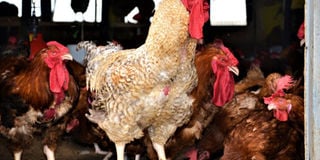Prime
Rainbow roosters will earn you more

A white Rainbow Rooster at Lunkuse farm weighing four kilogrammes at 10 months. PHOTO/GEORGE KATONGOLE
The kuroiler has for the past 10 years set the pass mark for dual purpose chicken. An Indian descent, it has been hailed for versatility among urban farmers since it was introduced in 2009 in a breed-testing pilot project conducted by Arizona State University (ASU) and the Uganda National Animal Genetic Resources Centre (NAGRC).
Quite significantly, a new dual purpose chicken, the Rainbow Roosters, is now turning heads with major breeding already in progress to assess its compatibility with the Ugandan conditions.
Indbro Research and Breeding Farms based in Hyderabad India engineered the versatile, multi-coloured, dual-purpose and low-input bird which Ugandan researchers say can offer an option to fighting malnutrition and ensuring financial security among smallholder farmers. In Uganda, Rainbow Rooster chicken was first distributed by Dr David Kayondo of Vet Frontiers.
In a recent interview Kayondo said the Rainbow Roosters are capable of producing about 300 eggs.
Mass breeding
Daniel Epinyu, the farm manager of Lusenke Government Stock Farm in Kayunga, where a breeding project started last year, says that the ‘Indbro Brown’ layers weigh 1.5kg at maturity and 2.5kgs at the end of laying. The cocks are estimated to weigh between 5-7kgs after 10 months. Yet they acquire slaughter weight by 19 weeks.
Government is preparing to implement backyard poultry production schemes among farmers across the country. Lusenke Stock Farm is acting as a mother unit taking care of the initial breeding. With an estimated 3,000 eggs being collected on a weekly basis, mass production will be done among organised farmers’ households in rural areas.
Tasty
Putting the hype aside, Rainbow Roosters have several advantages.
NAGRC is yet to test the Rainbow Roosters carcass quality but Epinyu says initial impressions point to a desirable bird quality. “They [Rainbow Roosters] are a good alternative to native birds and commercial fast-growing broilers because they are highly adaptable to conditions in Uganda yet they are disease resistant with feed efficiency as they can scavenge for food,” Epinyu explains.
This is the alternative needed by smallholder farmers to make informed decisions, he stresses.
Better than the Kuroiler?
Many farmers rush to buy new chicken breeds coming into the market without understanding their qualities only to end up regretting with a stressed profit margin. As the Rainbow Rooster gains popularity, it is important to be looked at in light of the evergreen Kuroiler.
Kenyan breeders are adding bird choices including Sasso, Kenbro and Kari chicken, which are available to Ugandan farmers.
Kayondo explained that for a farmer keeping chicken for meat, a Rainbow Rooster is the first choice as it gains more weight than any other breed.
“A Rainbow Rooster can weigh an average of three kilos while the Kuroiler in a similar time frame can weigh about two and half.,” he said. One big disadvantage with Rainbow Roosters is the one shared by Kuroilers. They are poor sitters and can never hatch their eggs. Therefore, they are only suitable for farmers with access to incubation facilities.
Epinyu says this is the reason they are working on sustainability to help poor farmers obtain chicks at the lowest cost possible. But he quickly mentions that Rainbow Roosters are more resistant to diseases compared to Kuroilers. “So, when someone is starting on improved indigenous chicken business, choosing the breed that best suits their purpose is important,” he says stressing that “ensure that you get your breeds from certified breeders for pure breeds.”
“Proper poultry standards must be observed,” Epinyu says.




